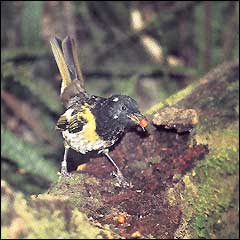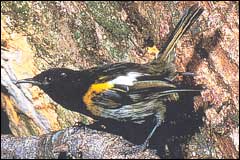|
|
|||
|
||||
|
Updated: September 6, 2001 |
|
|
||||||||||||||||||||||||||||||||||||||||||||||||||||||||||||||||||||||||||||||||||||||||||||||||||||||||
 A male stitchbird feeds on a coprosma berry |
Hihi (Stitchbirds) are the rarest of the New Zealand honeyeaters which includes birds like the tui and bellbird. They are similar in size to a bellbird. Hihi have obvious whiskers at the base of their beaks, and large round eyes.
Hihi eat fruit, nectar and invertebrates. Feeding takes place in the understorey and shrub layer because they are in competition with tui and bellbirds.
 Both male and female hihi have upward tilting tails |
They like to nest in dark confined cavities in tree trunks. They also roost in these places. Hihi are only one of two honeyeaters in the world that nest in tree hollows. The only remaining natural population of hihi is found on Little Barrier Island.
The male and female differ greatly in colouring. The male has bright golden shoulders and a black head and a bar of white on its chest. It has white feathers behind its eye and it's upper breast and wings are yellow. The female is olive brown with white on its chest and wing bar. Both male and female have an obvious upward tilting tail and a noisy call.
|
|
|
|
|
|
|
|
Male - black head and chest Yellow chest bar White wing bar and patch behind eyes Female - olive green to brown, white wing bar |
Gender differences Camouflage Warmth Carries pollen on head |
|
|
|
Chasing to defend territory |
|
|
|
Black |
Insect gleaning Pollination of flowers |
|
|
|
|
|
|
|
|
nest in tree hollow |
|